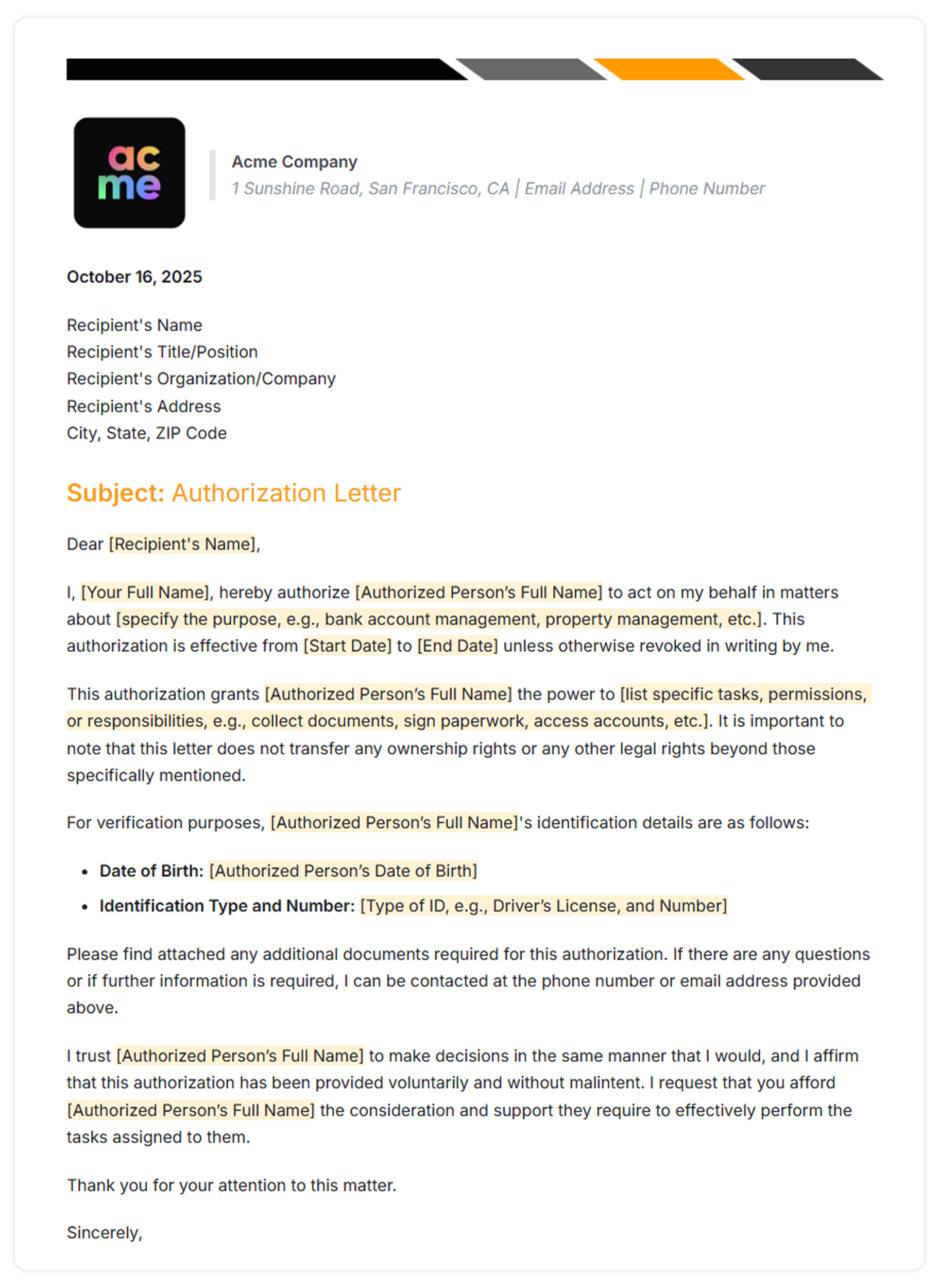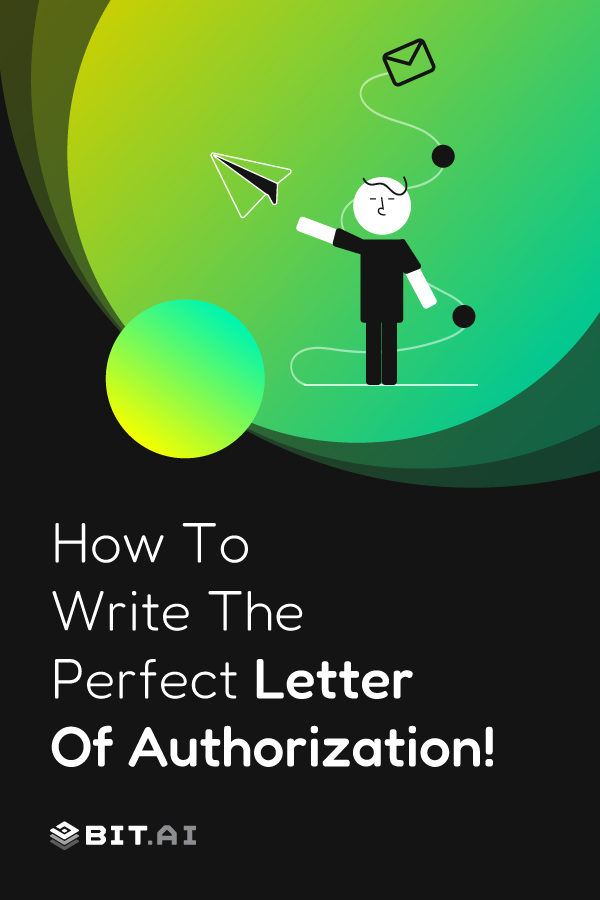Imagine this—you’re stuck in bed with a fever, and an urgent document needs to be collected. Or maybe you’re traveling and need someone to handle an official matter for you. You can’t just send a quick text saying, “Hey, can you take care of this?”—you need something more official.
That’s why you need a letter of authorisation, which is also called a permission letter. You can give permission to someone you trust with this easy but powerful document. This will make sure that everything runs smoothly while you’re away.
In this guide, we’ll walk you through what an authorization letter is, when you might need one, and—because we love making life easier for you—share some ready-to-use templates. Let’s get started!
What is a Letter of Authorization or Authority Letter?
A letter of authorization (or authority letter) is a legal document that allows a third party (usually referred to as an agent) to act on behalf of the person writing the letter.
In simple terms, when you write an authorization letter, you are legally permitting someone to act on your behalf. Since you remain directly accountable for their actions, it’s crucial to authorize only someone you trust.
Authorization Letter to Collect Documents
Let’s look at a certain type of authorisation letter now that we know what it is!
A letter of authorisation to collect documents is a formal document that lets someone you know get important papers for you.

This letter is useful if you are sick, on business trip, or unable to pick up personal records, certificates, or business papers. It makes sure that the handover goes smoothly and is legal proof that you give the bearer permission to collect the papers. This keeps things clear and avoids confusion or disagreements.
Many institutions—including banks, universities, and government offices—require a properly written authorization letter to verify the identities of both the authorizing party and the recipient.
Importance of a Letter of Authorization
1. Gives Credibility to Your Word
A written formal document verifies and legitimates your word. Let’s take an example of a letter of authorization when you’re sick and want your colleague to cover your work for two days.
Now, if you just inform him and he accepts it, depending on your company structure, the boss might not know, and the colleague could get in trouble. If anybody says something, showing that letter of authorization is enough to not cause any further problems.
Want every business message to be clear and professional? See how formal letters can help
2. Tracks Accountability
When you authorize someone to perform a task on your behalf, and they accept it, they are also accountable for the said task. In case of any mishap, the person can easily be tracked and held accountable.
For instance, you sent your junior to collect some documents on your behalf and give a letter of authorization for the same. On the way, he loses those documents. Now, he would be directly accountable for the loss and pay the compensation. If a written document were not given, you would be responsible for the loss.
3. Legally Binding Document
A letter of authorization consists of a person making a claim and signing underneath it. Both parties are required to sign the document. This makes it a legally binding document. If and when a legal issue arises, such a letter can be used as proof in the court proceeding
4. No Detail is Missed Out
When you write a letter of authorization, you clearly specify the name of the person, the date of authorization, and the duties that you are authorizing the person to perform. So if, in the future, they do more or less than what they were supposed to do, the document can be referred to for verification.
Speaking of details, what details should ideally be mentioned in an authority letter? What language should be used? How long should the document be? Let us explore the answers to all these questions in the next section.
How to Write a Letter of Authorization? Step-by-Step Guide
Writing an authorization letter to collect documents is simple when you follow a structured format. This type of letter serves as a formal permission slip, allowing another person to act on your behalf. To ensure a hassle-free experience, the letter should be professional, concise, and transparent about the permissions being granted. Follow these steps to write a polished letter of authorization!
Step 1. Start with Your Information
The information at the beginning of a letter of authorisation serves as legal proof that you are the person giving permission. Your full legal name, exactly as it appears on your official papers, should be written first, followed by your name, address, and phone number. Even though you don’t have to, including your email address can help the receiver get in touch quickly if they need to confirm any information. This part helps build trust and lets the recipient know who is approving the request.

Step 2. Date and info about the recipient
The date is an important part of your letter because it shows when the permission starts to work. Using a clear and standard date format, like “February 21, 2025,” makes sure there is no misunderstanding. Next, it’s important to be clear about who the message is for. If you authorise a particular person, be sure to include their full name and job title, if any. If the letter is to a business, including the name of the business and the name of any important departments makes the request go more quickly. Add the address of the recipient, even if it’s not required, so that legal records can be kept.
Want to master more professional documents? Dive into Business Letters: Definition, Types, Format, and Tips!
Step 3. Salutation
What kind of tone do you want your letter to have? If you are writing to a business, the government, or someone you don’t know, you should use a polite greeting like “Dear [Recipient’s Name]” or “To Whom It May Concern.” If the permission is for someone you know well, like a friend or family member, you can use a less formal tone, like “Dear [Recipient’s Name].” Using the right salutation makes sure that your conversation is professional and shows respect.
Step 4. Goals
At the heart of the letter is where you explain why the permission is needed and what it cover. To avoid confusion, it’s important to be clear about what you’re authorising. A direct sentence should make the purpose clear, like “I give [Name of Authorised Person] permission to get my bank statements from [Bank Name] on my behalf.” If the permission involves money transfers, getting packages, or signing formal papers, be very clear about what the person is allowed to do.
Equally important is defining the scope of the authorization. Instead of vaguely saying, “manage my accounts,” be specific—such as “withdraw funds up to $2,000 per month for household expenses.” If the authorized person is collecting documents, mention the exact documents they are permitted to retrieve. Setting these boundaries ensures that there is no overreach or misuse of the authorization.
Step 5. Details and Duration
This part makes things even clearer by including any details that will help the recipient understand what they can do. If the authorised person needs to show ID, make it clear what kinds of ID will work. Specify the exact dates if the permission is only valid for a certain amount of time. Like, “This permission is good from March 1, 2025, to March 30, 2025” or “This permission is good until it is revoked in writing.” Being clear about these details keeps things from getting confusing and helps institutions follow the authorisation properly.

Step 6. Closing and Signature
The letter should end with a formal closing statement, expressing gratitude or confirming that the instructions should be followed as stated. Common formal closings include “Sincerely,” “Respectfully,” or “Thank you for your attention to this matter.” Below the closing, your full name should be printed clearly to confirm your identity. On a physical letter, a handwritten signature in blue or black ink adds authenticity. For a digital letter, you can type your name and include “/s/” before it, which serves as a digital signature. Adding the date below the signature is optional but recommended for official documentation.
Step 7. Witness or Notary (If Required)
A witness or a notary public may be needed in some situations to add an extra layer of proof. A witness is any trusted adult over the age of 18 who sees you sign the letter and confirms that it is real. A notarised letter, on the other hand, is more legally strong if the permission is for important financial issues, real estate deals, or legal documents. A notary public is a government official who checks people’s names and signs documents to make sure they were signed freely. Whether you need a witness or a notary relies on the rules of the institution and how important the document is.
These steps will help you write a well-organised authorisation letter that is easy to understand, legal, and quick to process. Professional, short, and clear writing in the letter makes sure that everything goes smoothly for both the person making the request and the person receiving it.
By following these steps, you can create a well-structured authorization letter that is clear, legally sound, and easy to process. Keeping the letter professional, concise, and specific ensures a smooth experience for both the authorized person and the recipient handling the request.
Get Access to this Letter of Authorization Template for FREE!
Bit.ai is the ultimate AI-powered platform for creating professional documents and wikis tailored for various business needs.
Why Bit.ai is the Ultimate Tool for Writing Authorization Letters?
Now that you know all about authorization letters, what if we tell you that your next authorization letter can be a smart document with new-age appealing features?
Bit.ai brings all your information in one place by allowing you to organize information in workspaces and folders. You choose from 70+ pre-designed templates for creating your authorization letters.
Bit’s integrated documents make it easy for your team to collaborate intelligently across integrated smart documents. Collaborate on documents from anywhere in the world by co-editing, making inline comments, accessing version history, chatting via document chat, @mentions, and much more.
You can insert rich media in your documents with just a click. Bit makes your content come alive, be it a PDF file, OneDrive Excel sheet, Airtable databases, or more. For instance, if you attach a PDF file link to a Bit document or wiki, you can display the file as a visual embed and show the original format. It’s a smart way to weave various types of digital content together inside one document.
Once you complete your Authorization Letter, you can easily share it with the person you’re granting authority to, internal teams, and interested stakeholders via a shareable link or trackable link (Include a lead capture form, password protection, expiration date, etc.) You can also export it in various formats, including PDF, Word, etc.
FAQs
- How do I authorize someone on my behalf?To authorize someone, you must write a formal authorization letter stating their name, identification details, and the task they can perform. The letter should include your signature and, if required, a copy of your ID for verification. You may need to get the letter notarized or provide additional documents, depending on the institution.
- How do you give an authorization letter?After writing the letter giving permission to get the papers, print it out and sign it. Attach any copies of ID that are needed and give them to the person you’re authorising. It is important for them to bring the letter and ID to the place where they are picking up the papers. Some organisations may ask for more proof, so it’s best to find out what they need ahead of time.
- What is the best way to write a letter giving permission to get documents?To write a letter giving someone permission to collect papers, start with your name, address, and the date. Then, list the recipient’s information. Make it clear that you give permission for a certain person to gather the documents for you. List the names of the documents, the authorised person’s information, and any reference numbers that may apply. Formal and brief is best. Sign the letter and include a copy of your ID if asked
Keep Reading & Learning 📚
- Apology Letter: Definition, Format, Tips & Examples!
- Thank You Letters: What are they & How to Write a Perfect One?
- Complaint Letter: What is it & How to Create it? (With Examples)
- Proposal Letter: What is it & How to Write it?
- Cover Letter: What is it & How to Write it to Woo Recruiters?
- Leave of Absence Letter: What is it & How to Write it?





